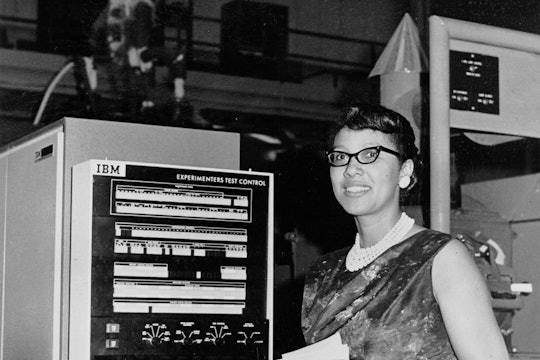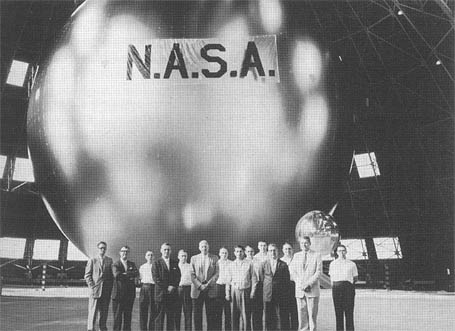
NASA
Meet Melba Roy Mouton, the Space Race mathematician and keeper of orbiting satellites
Roy Mouton, a mathematician and programmer, was a sort of hidden figure in Hidden Figures
There is something to be said about an individual who not only shaped science as we know it, but was also able to impart knowledge as a teacher. With science comes teaching, but often science comes alone. Melba Roy Mouton, who was born in Fairfax, Virginia, in 1929 to parents Rhodie and Edna Chloe, and graduated from Manassas Regional High School before attending college.
Roy Mouton's specialty was math. She held both a bachelor's and a master’s in the subject from Howard University, where she also participated in Future Teachers of America as an undergraduate student. She graduated during the precarious time between World War II and the Space Race with Soviet Russia. Roy Mouton’s career was not theoretical in practice, but rather applied — she first focused on statistics within government work, and used her skills there. She employed her multiple degrees in math for both the Army Map Service and the Census Bureau, which focused on the plotting of future neighborhoods and other places of population expansion, an incredibly important job during the famous 'baby boom' of the post-World War II era in the United States of America.
Her work analyzing statistics of populations showed an aptitude for interpreting data in a format easy for other scientists and engineers to understand. Roy Mouton moved to NASA, where she began analyzing and following new objects sent into space. Her initial focus was Echo 1, one of the first satellites used to orbit Earth in order to help communications across the globe. In addition to transmitting communications through both reflecting ground based transmissions and creating a two-way system for parties to contact each other, Echo 1 also served as a concrete example of why the space program — then in its infancy — needed to be funded and expanded to include more celestial objects, including the hiring of more computers and the eventual flying of astronauts into space.

Her initial focus was Echo 1, one of the first satellites used to orbit Earth in order to help communications across the globe.
NASA
Roy Mouton's responsibility for tracking the Echo 1 was not an easy task, and it required the mastery of multiple tracking formats in order to recover data in regards to charting the movement of the object. These tracking formats were as diverse as optical (using images from telescopes and screens), digital primary/secondary tracking (following transmittable data from the NASA Minitrack) and radar, which pinged different locations from across the globe and the atmosphere.
Perhaps due to her ability to interpret different formats of data (thanks to her time at the Maps department of the Census Bureau) or her ability to predict the movement of satellites, Roy Mouton's skills attracted the notice of her superiors, who gave her additional projects to work on as computers roles adapted to different forms of communication. Namely, her abilities made her a prime candidate to work with programming languages, such as APL, one of the first languages used in code, a new technology necessary when working with complex mechanics, space launches, and plotting orbits.
She got promoted. Her new role as Assistant Chief of Research Programs at NASA's Trajectory and Geodynamics Division meant that she was responsible for overseeing all of the human "computers," individuals creating and interpreting complex (and sometimes long winded) calculations in order to make sure projections and communications were done correctly. Some of these computers you may recognize, such as Mary Jackson, Katherine Johnson and Dorothy Vaughan — main characters in the movie, Hidden Figures.
Though depicted in the film, Roy Mouton’s story may be familiar. Like many other women of color working at NASA in the 1960s, her math skills were used to track celestial objects, an important role that was crucial in not only figuring out where satellites and shuttles were heading, but in tracking and setting the course as well. Satellites have continued to play a role in communications and directions ever since, and had Roy Mouton not been able to analyze and track their movements, many of the technologies that we take for granted (such as the tablet or phone that you're reading this article on!) would not be possible.
Important as her job in analyzing data and tracking objects were, like many other women and people of color working behind the scenes at NASA, Roy Mouton did not receive the same amount of glory as other scientists and astronauts during this time in American history, but her skills in programming would lead her down another road.
The Space Race was not only instrumental in spurring advancements in flight and space travel, but also in communication through the design of programming languages. At this time, some of the first programming languages were being developed to better program the technology that was necessary to keep propelling the American Space Program. Although other languages and mathematical coding had been designed and used for communication within technology, none had the application that this new language, designed by Kenneth Iverson, did. Called simply, "A Programming Language" (APL), this ancestor of modern coding was designed for statisticians to program computers and other pieces of technology to follow different tasks, rather then simply serve as a series of data transferred across different, more complex machines then before. This was a necessary step in allowing multiple shuttles, computers, and other matters of technology to be deployed, and for a statistician used to large amounts of data and multiple projects at once, Roy Mouton was able to learn and apply the language quickly.
Though she was working within analysis and programming for the American government right after she finished her education, Roy Mouton had another skill set up her sleeve. If you've ever had to learn a new coding language for a specific goal, you're familiar with how difficult it can be. Because of her specialty with APL, Roy Mouton was asked to lead classes on coding, just as she had managed and trained the human computers at NASA. This paired well with her interest in teaching, which called back to her time at Howard University.
Soon, she was helping create seminars on APL programming, at a time when coding was not only being taught to further academic science and technology, but also in the business world, where computers were starting, in the 1970s, to find themselves in more and more American offices. Data in all manners was being used to better project outcomes and predict the future, and Roy Mouton was not only literate in this language, but thanks to her experience in both NASA and the Census, was an expert.
Roy Mouton retired from NASA in 1973, living in Silver Spring, Maryland. She passed away in 1990, at the age of 61, from brain cancer.
Roy Mouton advanced discoveries in science, but also in technology as we know it. Her contributions to computer science education might have a can't be overstated, with the advancing number of enrollments in coding boot camps have been focused on adult learners looking to gain skills outside of the classroom. But her contributions to the ability to predict movement of celestial objects should not be understated. To quote astrophysicist Chanda Prescod-Weinstein, "what she did was extremely intense, difficult work. The goal of the work, in addition to ensuring satellites remained in a stable orbit, was to know where everything was at all times. So they had to be able to calculate with a high level of accuracy."
